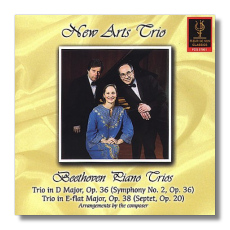
The Internet's Premier Classical Music Source
Related Links
- Beethoven Reviews
- Latest Reviews
- More Reviews
-
By Composer
-
Collections
DVD & Blu-ray
Books
Concert Reviews
Articles/Interviews
Software
Audio
Search Amazon
Recommended Links
Site News
 CD Review
CD Review
Ludwig van Beethoven

Trio Transcriptions
- Trio in D Major, Op. 36 (after Symphony #2)
- Trio in E Flat Major, Op. 38 (after Septet, Op. 20)
New Arts Trio
(Rebecca Penneys, piano;
Yair Kless, violin;
Arie Lipsky, cello)
Fleur de Son FDS 57931 DDD 66:24
Don't let this sleeper CD pass you by. It's loaded with charm and expert musicianship. More than that, it has the potential to really confuse your friends as they hear familiar music played by an unexpected combination of instruments.
At the dawn of the 19th century, music appreciation was increasingly becoming an activity for more than just the privileged rich. The average family, in hopes of social advancement, wanted to display some proficiency, particularly among its female members, in the fine arts. Arrangements were a popular way for amateur musicians (who could be very accomplished indeed) to familiarize themselves with the new concert music of the day. Beethoven wanted exposure as much as the next composer, and he himself arranged his fairly well-known Septet (for violin, viola, cello, bass, clarinet, horn, and bassoon) for the forces used on this CD. Whether or not he did it himself (the task might have fallen, at least in part, to his pupil Ferdinand Ries), he also approved of this arrangement of his Second Symphony.
Oddly enough, the symphony makes the transition better than the septet. Beethoven showed great imagination and creativity in reassigning the orchestral parts to just three instruments. Parts originally written for strings are given to the piano as often as not, and repeated material whose scoring was unvaried in the orchestral version sometimes is varied in the trio arrangement. The result is viable and very appealing. I miss the sounds of the wind instruments in the Septet arrangement. Here, the piano takes a prominent role filling in the gaps. Nevertheless, Beethoven's melodic inspiration is strong, and the music remains highly enjoyable in this more intimate presentation. It's ironic that the Septet's popularity was aided by an arrangement in the opposite direction; conductor Arturo Toscanini loved this music, and he played it with the NBC Symphony Orchestra in a version that beefed up the string section to twelve violins, ten violas, eight cellos, and five basses. (He felt that the right balance between the strings and the winds was unachievable in the original version.)
The New Arts Trio has been around since 1974, but Kless and Lipsky joined it only seven and three years ago, respectively. Penneys is a Professor of Piano at the Eastman School of Music, Kless teaches in Graz (Austria) and Tel-Aviv, and Lipsky conducts and plays principal cello with the Buffalo Philharmonic. He also teaches at SUNY Buffalo. Together, they play as one while retaining their individual personalities. Theirs is an ingratiating sound and a very musicianly presentation. On this recording, the balance between the instruments is ideal. It was taped at the Eastman School of Music in July 1997. Please consider giving this a try, if you like nutritious ear-candy.
Copyright © 1999, Raymond Tuttle




















